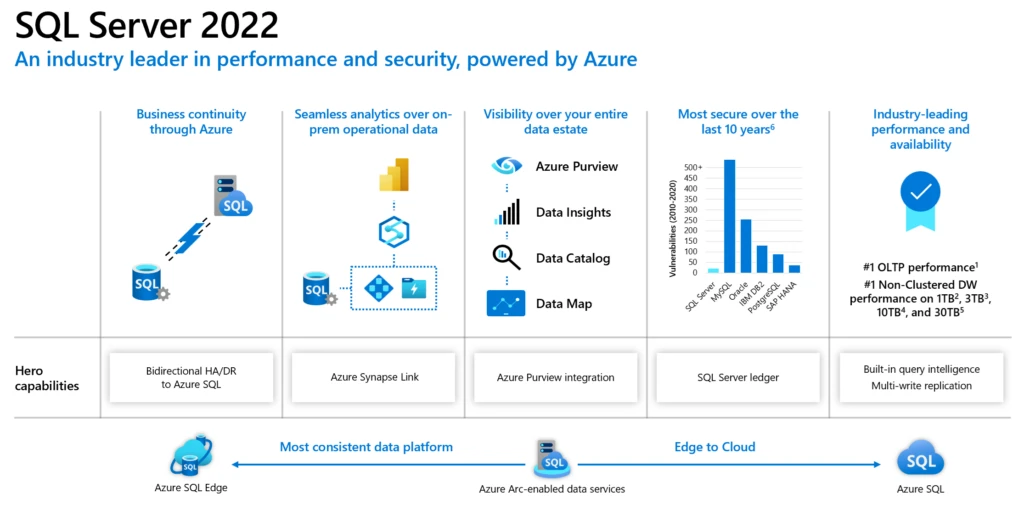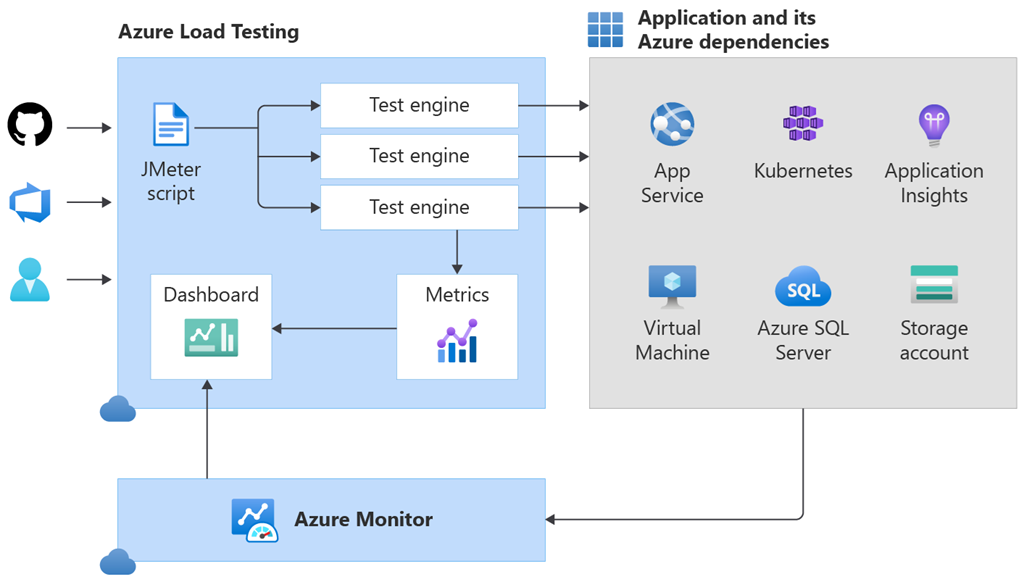Azure News December 2021
Announcing SQL Server 2022 preview
In November Microsoft announced the preview of SQL Server 2022, the most Azure-enabled release of SQL Server yet, with continued innovation in performance, security, and availability. The latest SQL Server offering promises to provide:
- Business continuity through Azure
- Seamless analytics over on-prem operational data
- Visibility over entire data estate
- Most secure solution over the last 10 years
- Industry leading performance and availability

SQL Server 2022. Source: Microsoft.
Learn more about the SQL Server 2022 release and register for the preview here.
What’s new in Azure Virtual Desktop?
Every month Microsoft update Azure Virtual Desktop (AVD) to ensure the best user experience. Some of the latest changes include:
- AVD for Azure Stack HCI is now in public preview
- Autoscale public preview
- Azure Virtual Desktop starter kit for Power Automate
- New documentation on tagging with AVD
You can explore all the latest changes here.
Webinar: 6 Things ISVs Need to Know About the Azure Transition
Join us on 19th January 2022 as our ISV expert and Microsoft Practice Lead, Andrew Slater, will explain how ISVs benefit from Azure’s nimble, customisable, compliant environment, without having to make wholesale redevelopments to your applications. The event will explore:
- Building: zero constraint scaling, open source and framework support
- Capabilities: ISV favourites and Microsoft’s AI portfolio demystified
- Hybrid cloud: options to integrate with your current environments
- Security: the stack, must-know statistics, and extra support for ISVs
- Vendors: flexibility and payments for a typical vendor
- Support: switching to the platform alone vs. with a partner
Find out more about our webinar and register here.
Provide limitless database scale and performance
At Microsoft Ignite last month Microsoft released many new Azure Cosmos DB capabilities such as partial document updates, provisioned throughput maximums, and cost-savings recommendations in Azure Advisor—all generally available. In addition, Azure Synapse Link custom partitioning, Cassandra API server-side retries, and a Logic App connector are now in preview.
To learn about these updates and other updates, visit the Azure Cosmos DB blog.
Azure Migration and Modernization Program expands to support new scenarios
Over the last few years, Azure Migration and Modernization Program (AMMP) has helped thousands of customers unlock the benefits of the cloud, with the right mix of expert guidance and best practices at every stage of their journey. In November Microsoft announced support for additional scenarios in AMMP:
- Infrastructure: AMMP will help customers plan and move their SAP environments to Azure, including both SAP lift-and-shift and SAP HANA deployments
- Azure Red Hat OpenShift: AMMP will now help customers move their Red Hat OpenShift environments to Azure as part of their application modernisation initiatives
- Cloud-native apps: AMMP will help customers innovate and build new cloud-native apps using common app patterns like serverless, containers, and microservices architectures
- Hybrid and security: AMMP will help customers with deploying Azure Arc to workloads that aren’t planned or ready to move yet
You can read the full announcement here.
Azure Cost Management and Billing updates
No matter the size of your business it’s important to know what you’re spending, where, and how you can reduce those costs. This is where Azure Cost Management and Billing comes in. Here are some of the latest improvements and updates based on user feedback:
- Schedule automated emails of your saved cost views
- New cost recommendations for Azure Data Explorer and Cosmos DB
- Multitasking in the cost analysis preview now enabled by default in Labs
- Identify subscription cost anomalies with insights in the cost analysis preview
- Subscribe to updates of your saved cost views
- New ways to save money with Azure
- Plus, much more…
So, grab a drink and have a read of all the latest improvements and updates here.
Optimise app performance at scale with Azure Load Testing
Azure Load Testing is a fully managed Azure service that enables developers and testers to generate high-scale load with custom Apache JMeter scripts and gain actionable insights to catch and fix performance bottlenecks at scale. The service is designed to help testers and developers who are taking on a larger role in validating app quality, performance, and scalability.

Azure Load Testing architecture overview. Source: Microsoft.
You can get started with Azure Load Testing by creating an Azure Load Testing resource in the Azure portal.
Track, measure, and mitigate faults in your applications with Azure Chaos Studio
Last month Microsoft announced the preview of Azure Chaos Studio, a service which enables customers to model and deliberately introduce faults that simulate real-world outages and validate how their application performs under those scenarios.
With Azure Chaos Studio you can:
- Spend more time learning about application resiliency, without managing tools and scripts
- Get started quickly with agent-based faults that disrupt within resources, and service-based faults that disrupt resources at the control plane
- Validate product quality wherever and whenever you want with CI/CD pipeline integration, using both to monitor production quality through continuous validation
IN OTHER NEWS:
Simplify connectivity, routing, and security with Azure Virtual WAN
Enhance third-party NVA availability with Azure Gateway Load Balancer—now in preview
Further Insights
Webinar: 6 Things ISVs Need to Know About the Azure Transition
Join us on 19th January 2022 as we explore how ISVs benefit from Azure’s environment, without having to make wholesale redevelopments to applications.
Microsoft Azure 101: The Beginner's Guide to Azure
New to Azure? Keen to refresh your memory? Grab a cuppa and take a deep dive into the world of Azure with our free, downloadable beginner’s guide.
Keep updated with the latest Azure News
Did you enjoy the latest Azure News? Grab yourself a coffee and have a read of last month’s newsletter to make sure you are kept updated and didn’t miss anything.



